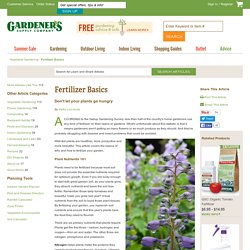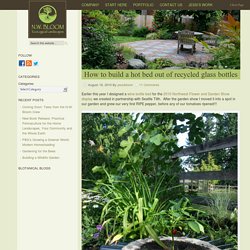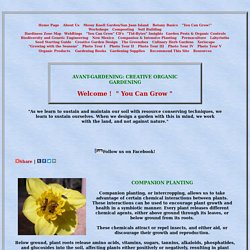

Fertilizer Basics: Organic Fertilizer, NPK Ratio. ACCORDING to the Gallup Gardening Survey, less than half of the country's home gardeners use any kind of fertilizer on their lawns or gardens.

What's unfortunate about this statistic is that it means gardeners aren't getting as many flowers or as much produce as they should. And they're probably struggling with disease and insect problems that could be avoided. To look their best, most perennials require regular fertilization. Well-fed plants are healthier, more productive and more beautiful. This article covers the basics of why and how to fertilize your garden. Plant Nutrients 101 Plants need to be fertilized because most soil does not provide the essential nutrients required for optimum growth. There are six primary nutrients that plants require. Nitrogen helps plants make the proteins they need to produce new tissues.
Phosphorus stimulates root growth, helps the plant set buds and flowers, improves vitality and increases seed size. Potassium improves overall vigor of the plant. Build a Hot Bed for Warm Climate Plants. Earlier this year I designed a wine bottle bed for the 2010 Northwest Flower and Garden Show display we created in partnership with Seattle Tilth.

After the garden show I moved it into a spot in our garden and grew our very first RIPE pepper, before any of our tomatoes ripened!!! Ripe pepper in a wine bottle bed The idea is simple: the sunlight warms up the air inside the glass and expands. The heated air is pushed through the bottle neck into the soil warming it, and the plant growing in the soil. Because of the limited size of the garden show display we made it small and in a circle large enough for one plant. Follow these steps: collect bottles (wine, beer or soda) that is the fun part! This is a great way to grow warmth loving crops that don’t normally thrive in a limited growing season. Herbal Seed Growing. No garden is complete without herbs!

In general, they are easy-to-grow and quite happy in poor, gravelly soils. There can never be substitution for freshness, and there's no doubt that fine cuisine and fresh herbs are synonymous. Besides adding gourmet delicacy to meals, herbs serve as insect repellents in your garden, add color to your life and are your password to self-reliant health. Integrating a Pond and Birds. Building Plans - ~$250 Shade covered "GreenzBox" We constructed a 4' x 8' (32 square feet) raised bed vegetable garden which we call the "GreenzBox"™.

It is a high raised bed covered with shadecloth held up by a PVC frame. The shadecloth can be opened during the day, and closed at night to protect from frost and critters. We filled it with sifted garden compost from years of growing for the local farmers market. We used a method of organic bio-intensive planting which allowed the plants to be closely spaced, using fewer nutrients, less water, and produced six times more food in less space.
The GreenzBox™, a culmination of years of gardening trial and error, is proving to be the ultimate fruit of our endeavors, not only for an abundance of our own fresh organic greens, but it is also proving to be a means by which to convey a spirit of fellowship and cooperation - the foundation for real growth - and the realization that self-reliance at the community level strengthens the whole of society. Resources. Biointensive Mini-Farm Plan w/ Software and Books. We have dedicated our research to rediscovering the scientific principles that underlie millennia-old traditional farming systems.

These have guided us to the eight essential aspects that are the foundation of GROW BIOINTENSIVE: Double-Dug, Raised Beds Composting Intensive Planting Companion Planting Carbon Farming Calorie Farming The Use of Open-Pollinated Seeds A Whole-System Farming Method Image © 1995 Jim Bones Most life in nature occurs at the interface of soil, water, air and sun. GROW BIOINTENSIVE soil preparation practices create growing beds with more surface area to maximize the effect of nature’s life processes.
GROW BIOINTENSIVE mini-farming techniques make it possible to grow food using: 67% to 88% less water 50% to 100% less fertilizer 99% less energy than commercial agriculture, while using a fraction of the resources These techniques can also: Globally, the health of farming is being threatened by severe challenges: Small-scale farming is as old as agriculture itself. Companion & Intensive Planting. A garden planted with single rows uses more soil area and resources, is more difficult to mulch, the soil dries out faster and produces more weeds, and becomes quickly compacted from walking and jumping between rows.

Planting crops closely together in wide rows, takes advantage of the physical and chemical characteristics of each plant. Planting crops close together for the highest yield of each plant will benefit each plant, if planted in symbiotic relationship. An intensive intercropping in 3 to 5 foot wide raised beds will provide the most efficient use of soil area. Framing the edges with soil, brick, stone, or wood will provide an area of containment for the soil, organic nutrients, water, and mulch. Plant foliage can be used to provide an area of “living shade”, promoting water, nutrient and soil, conservation. Successive planting means that you do not plant all your seeds at the same time in one big crop. Space Saving Complimentary Growth Combinations Resources Planet Natural.